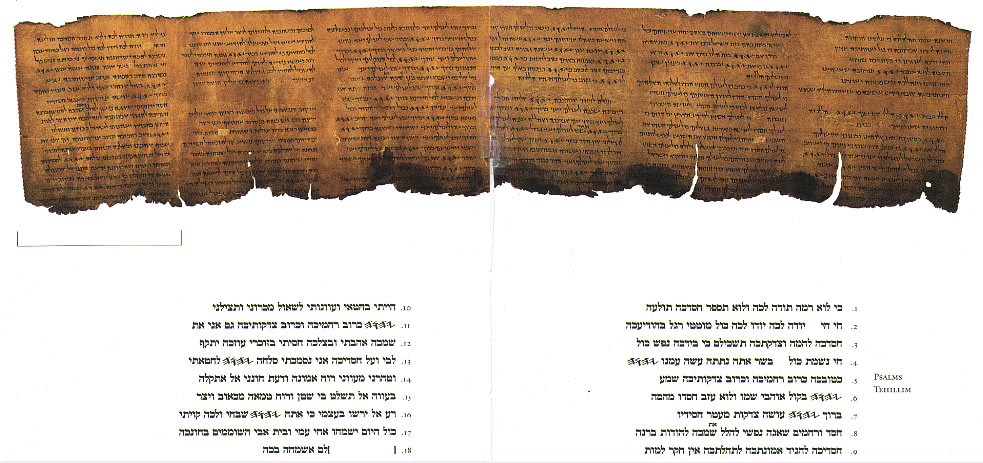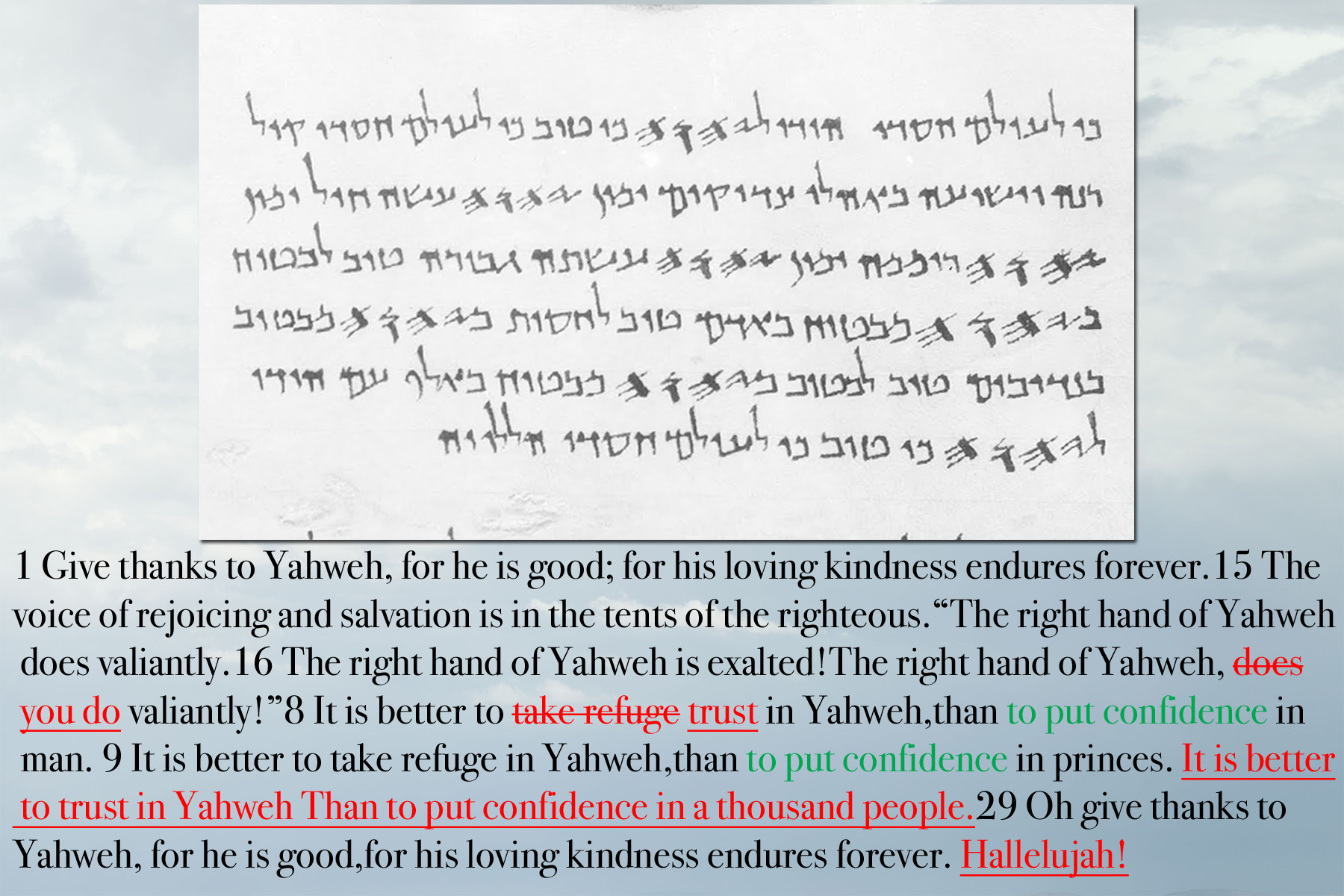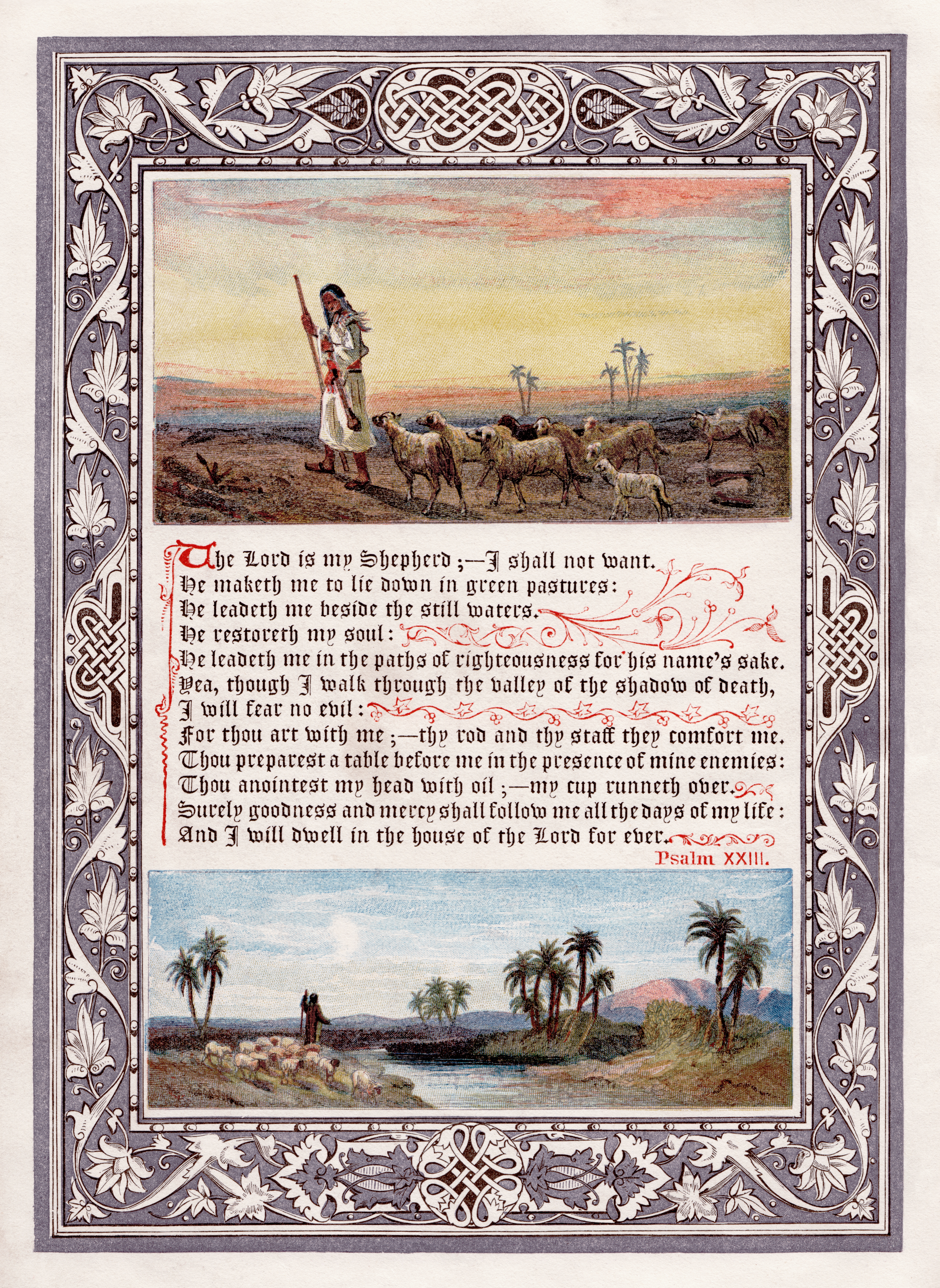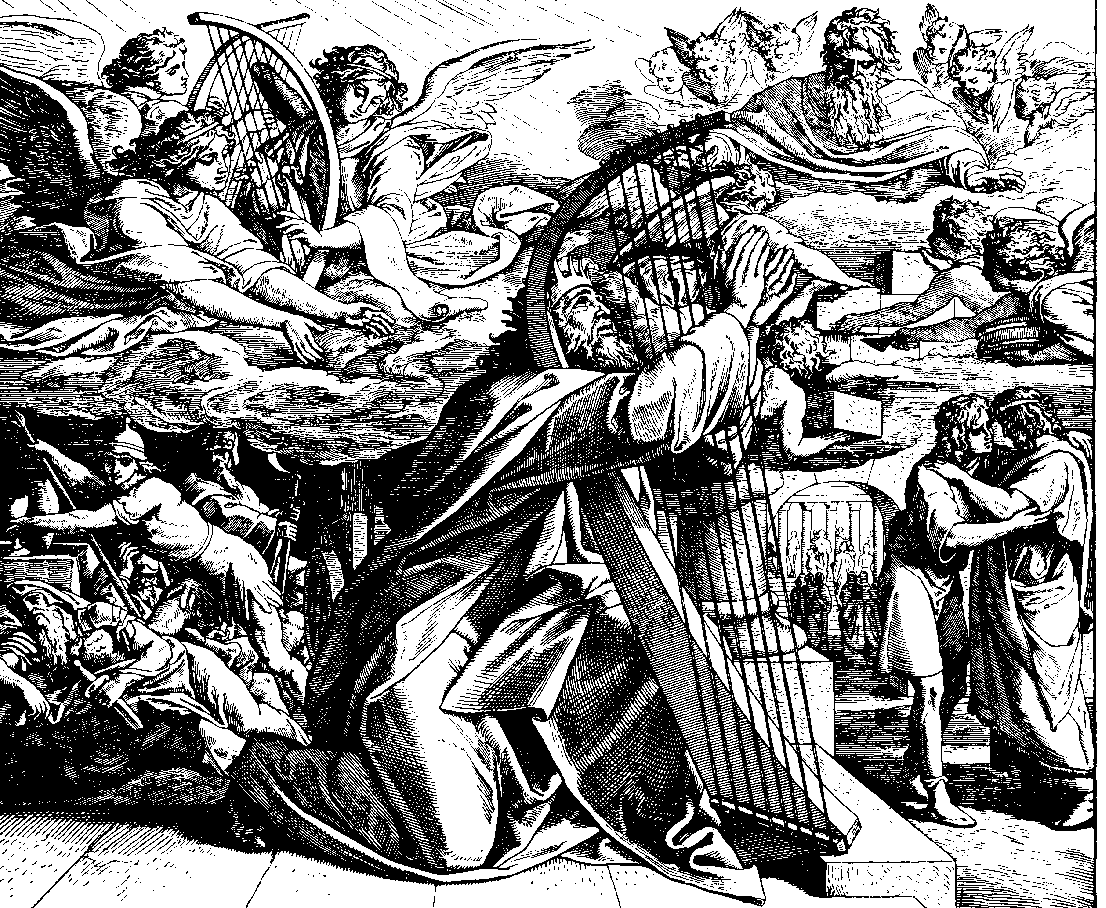|
The Great Psalms Scroll
The Great Psalms Scroll, also referred to as 11Q5, is the most substantial and well preserved Dead Sea Scrolls Psalms manuscript of the thirty-seven discovered in the Qumran caves, six of which were discovered in Cave 11. Description The scroll was discovered in February of the year 1956, ten years after the initial discovery of the scrolls. It was purchased by The Palestine Archaeological Museum located in Jerusalem and first unrolled in November 1961. Four fragments of this scroll were later purchased by the same museum. The scroll's physical make up is that of dark yellow animal hide and is a little less than 1 mm thick. The primary body of the manuscript consists of “5 sheets of leather, still sewn together”, and is 4.253 meters in length. It is estimated to have been copied anywhere from 30-50 AD, and is written in Biblical style Hebrew. When rolled out, it forms a slight arc, and the top part is clean and well kept, while the bottom is decomposing significantly. It ... [...More Info...] [...Related Items...] OR: [Wikipedia] [Google] [Baidu] |
Dead Sea Scrolls
The Dead Sea Scrolls (also the Qumran Caves Scrolls) are ancient Jewish and Hebrew religious manuscripts discovered between 1946 and 1956 at the Qumran Caves in what was then Mandatory Palestine, near Ein Feshkha in the West Bank, on the northern shore of the Dead Sea. Dating from the 3rd century BCE to the 1st century CE, the Dead Sea Scrolls are considered to be a keystone in the history of archaeology with great historical, religious, and linguistic significance because they include the oldest surviving manuscripts of entire books later included in the biblical canons, along with deuterocanonical and extra-biblical manuscripts which preserve evidence of the diversity of religious thought in late Second Temple Judaism. At the same time they cast new light on the emergence of Christianity and of Rabbinic Judaism. Most of the scrolls are held by Israel in the Shrine of the Book at the Israel Museum, but their ownership is disputed by Jordan due to the Qumran Caves' history: f ... [...More Info...] [...Related Items...] OR: [Wikipedia] [Google] [Baidu] |
Septuagint
The Greek Old Testament, or Septuagint (, ; from the la, septuaginta, lit=seventy; often abbreviated ''70''; in Roman numerals, LXX), is the earliest extant Greek translation of books from the Hebrew Bible. It includes several books beyond those contained in the Masoretic text of the Hebrew Bible as canonically used in the tradition of mainstream Rabbinical Judaism. The additional books were composed in Greek, Hebrew, or Aramaic, but in most cases, only the Greek version has survived to the present. It is the oldest and most important complete translation of the Hebrew Bible made by the Jews. Some targums translating or paraphrasing the Bible into Aramaic were also made around the same time. The first five books of the Hebrew Bible, known as the Torah or the Pentateuch, were translated in the mid-3rd century BCE. The remaining translations are presumably from the 2nd century BCE. The full title ( grc , Ἡ μετάφρασις τῶν Ἑβδομήκοντα, , The Translat ... [...More Info...] [...Related Items...] OR: [Wikipedia] [Google] [Baidu] |
1st-century Biblical Manuscripts
The 1st century was the century spanning AD 1 ( I) through AD 100 ( C) according to the Julian calendar. It is often written as the or to distinguish it from the 1st century BC (or BCE) which preceded it. The 1st century is considered part of the Classical era, epoch, or historical period. The 1st century also saw the appearance of Christianity. During this period, Europe, North Africa and the Near East fell under increasing domination by the Roman Empire, which continued expanding, most notably conquering Britain under the emperor Claudius (AD 43). The reforms introduced by Augustus during his long reign stabilized the empire after the turmoil of the previous century's civil wars. Later in the century the Julio-Claudian dynasty, which had been founded by Augustus, came to an end with the suicide of Nero in AD 68. There followed the famous Year of Four Emperors, a brief period of civil war and instability, which was finally brought to an end by Vespasian, ninth Roman emperor, a ... [...More Info...] [...Related Items...] OR: [Wikipedia] [Google] [Baidu] |
Qumran
Qumran ( he, קומראן; ar, خربة قمران ') is an archaeological site in the West Bank managed by Israel's Qumran National Park. It is located on a dry marl plateau about from the northwestern shore of the Dead Sea, near the Israeli settlement and kibbutz of Kalya. The Hellenistic period settlement was constructed during the reign of Hasmonean leader John Hyrcanus () or somewhat later. Qumran was inhabited by a Jewish community of the late Second Temple period, which most scholars identify with the mystic sect of the Essenes; however, other groups were also suggested. It was occupied most of the time until and was destroyed by the Romans during the First Jewish-Roman War, possibly as late as 73 CE. It was later used by Jewish rebels during the Bar Kokhba Revolt. Today, the Qumran site is best known as the settlement nearest to the Qumran Caves where the Dead Sea Scrolls were hidden, caves in the sheer desert cliffs and beneath, in the marl terrace. The principa ... [...More Info...] [...Related Items...] OR: [Wikipedia] [Google] [Baidu] |
Psalms
The Book of Psalms ( or ; he, תְּהִלִּים, , lit. "praises"), also known as the Psalms, or the Psalter, is the first book of the ("Writings"), the third section of the Tanakh, and a book of the Old Testament. The title is derived from the Greek translation, (), meaning "instrumental music" and, by extension, "the words accompanying the music". The book is an anthology of individual Hebrew religious hymns, with 150 in the Jewish and Western Christian tradition and more in the Eastern Christian churches. Many are linked to the name of David, but modern mainstream scholarship rejects his authorship, instead attributing the composition of the psalms to various authors writing between the 9th and 5th centuries BC. In the Quran, the Arabic word ‘Zabur’ is used for the Psalms of David in the Hebrew Bible. Structure Benedictions The Book of Psalms is divided into five sections, each closing with a doxology (i.e., a benediction). These divisions were probably intro ... [...More Info...] [...Related Items...] OR: [Wikipedia] [Google] [Baidu] |
Patrick W
Patrick may refer to: *Patrick (given name), list of people and fictional characters with this name *Patrick (surname), list of people with this name People *Saint Patrick (c. 385–c. 461), Christian saint *Gilla Pátraic (died 1084), Patrick or Patricius, Bishop of Dublin * Patrick, 1st Earl of Salisbury (c. 1122–1168), Anglo-Norman nobleman * Patrick (footballer, born 1983), Brazilian right-back *Patrick (footballer, born 1985), Brazilian striker *Patrick (footballer, born 1992), Brazilian midfielder *Patrick (footballer, born 1994), Brazilian right-back *Patrick (footballer, born May 1998), Brazilian forward *Patrick (footballer, born November 1998), Brazilian attacking midfielder *Patrick (footballer, born 1999), Brazilian defender *Patrick (footballer, born 2000), Brazilian defender *John Byrne (Scottish playwright) (born 1940), also a painter under the pseudonym Patrick *Don Harris (wrestler) (born 1960), American professional wrestler who uses the ring name Patrick Film ... [...More Info...] [...Related Items...] OR: [Wikipedia] [Google] [Baidu] |
Peter Flint (religious Scholar)
Peter W. Flint was involved in research of the Dead Sea Scrolls for over 20 years. He was one of the 70 official members of the Dead Sea Scrolls editors worldwide. As the controversy of publishing of the Dead Sea Scrolls escalated, in 1987 he moved from South Africa to the University of Notre Dame in Indiana where he took a doctoral fellowship and began to study under Eugene Ulrich, the chief editor of the biblical Dead Sea Scrolls and one of the central figures of the controversy. In 1997, Flint finished publishing the Psalms Scrolls: the second largest portion of the biblical Dead Sea Scrolls. This publication is full of discoveries providing insights for Bible translations, Bible study and biblical scholarship. Flint was an editor of the largest intact scroll: The Great Isaiah Scroll. He served at Trinity Western University as a Professor of Religious Studies, the Canada Research Chair in Dead Sea Scrolls Studies, and a director of the Dead Sea Scrolls Institute. He died on Novembe ... [...More Info...] [...Related Items...] OR: [Wikipedia] [Google] [Baidu] |
Hebrew Bible
The Hebrew Bible or Tanakh (;"Tanach" ''Random House Webster's Unabridged Dictionary''. Hebrew: ''Tānāḵh''), also known in Hebrew as Miqra (; Hebrew: ''Mīqrā''), is the Biblical canon, canonical collection of Hebrew language, Hebrew scriptures, including the Torah, the Nevi'im, and the Ketuvim. Different branches of Judaism and Samaritanism have maintained different versions of the canon, including the 3rd-century Septuagint text used by Second-Temple Judaism, the Syriac language Peshitta, the Samaritan Torah, the Dead Sea Scrolls, and most recently the 10th century medieval Masoretic Text, Masoretic text created by the Masoretes currently used in modern Rabbinic Judaism. The terms "Hebrew Bible" or "Hebrew Canon" are frequently confused with the Masoretic text, however, this is a medieval version and one of several ... [...More Info...] [...Related Items...] OR: [Wikipedia] [Google] [Baidu] |
11Q5 (Psalm 151)
The Great Psalms Scroll, also referred to as 11Q5, is the most substantial and well preserved Dead Sea Scrolls Book of Psalms, Psalms manuscript of the thirty-seven discovered in the Qumran Caves, Qumran caves, six of which were discovered in List of manuscripts from Qumran Cave 11, Cave 11. Description The scroll was discovered in February of the year 1956, ten years after the initial discovery of the scrolls. It was purchased by The Palestine Archaeological Museum located in Jerusalem and first unrolled in November 1961. Four fragments of this scroll were later purchased by the same museum. The scroll's physical make up is that of dark yellow animal hide and is a little less than 1 mm thick. The primary body of the manuscript consists of “5 sheets of leather, still sewn together”, and is 4.253 meters in length. It is estimated to have been copied anywhere from 30-50 AD, and is written in Biblical style Hebrew. When rolled out, it forms a slight arc, and the top part is ... [...More Info...] [...Related Items...] OR: [Wikipedia] [Google] [Baidu] |
Psalm 151
Psalm 151 is a short psalm found in most copies of the Septuagint (LXX), but not in the Masoretic Text of the Hebrew Bible. The title given to this psalm in the Septuagint indicates that it is supernumerary, as no number is affixed to it. The psalm is ascribed to David. It is also included in some manuscripts of the Peshitta. The psalm concerns the story of David and Goliath. The Eastern Orthodox, Coptic Orthodox, Armenian Apostolic, and Syrian Orthodox churches accept Psalm 151 as canonical. Catholics, Protestants, and most Jews consider it apocryphal. However, it is found in some Catholic Bibles, such as certain editions of the Latin Vulgate, as well as in some ecumenical translations, such as the Revised Standard Version. Psalm 151 is cited once in the Extraordinary Form of the Roman Breviary, as a responsory of the series from the books of Kings, the second in the Roman Breviary, together with (Greek 1–2 Kings = trad. 1–2 Samuel; Greek 3–4 Kings = trad. 1–2 Kings) in ... [...More Info...] [...Related Items...] OR: [Wikipedia] [Google] [Baidu] |
Book Of Psalms
The Book of Psalms ( or ; he, תְּהִלִּים, , lit. "praises"), also known as the Psalms, or the Psalter, is the first book of the ("Writings"), the third section of the Tanakh, and a book of the Old Testament. The title is derived from the Greek translation, (), meaning "instrumental music" and, by extension, "the words accompanying the music". The book is an anthology of individual Hebrew religious hymns, with 150 in the Jewish and Western Christian tradition and more in the Eastern Christian churches. Many are linked to the name of David, but modern mainstream scholarship rejects his authorship, instead attributing the composition of the psalms to various authors writing between the 9th and 5th centuries BC. In the Quran, the Arabic word ‘Zabur’ is used for the Psalms of David in the Hebrew Bible. Structure Benedictions The Book of Psalms is divided into five sections, each closing with a doxology (i.e., a benediction). These divisions were probably introdu ... [...More Info...] [...Related Items...] OR: [Wikipedia] [Google] [Baidu] |
Psalm 118 Dead Sea Scrolls
The Book of Psalms ( or ; he, תְּהִלִּים, , lit. "praises"), also known as the Psalms, or the Psalter, is the first book of the ("Writings"), the third section of the Tanakh, and a book of the Old Testament. The title is derived from the Greek translation, (), meaning "instrumental music" and, by extension, "the words accompanying the music". The book is an anthology of individual Hebrew religious hymns, with 150 in the Jewish and Western Christian tradition and more in the Eastern Christian churches. Many are linked to the name of David, but modern mainstream scholarship rejects his authorship, instead attributing the composition of the psalms to various authors writing between the 9th and 5th centuries BC. In the Quran, the Arabic word ‘Zabur’ is used for the Psalms of David in the Hebrew Bible. Structure Benedictions The Book of Psalms is divided into five sections, each closing with a doxology (i.e., a benediction). These divisions were probably introdu ... [...More Info...] [...Related Items...] OR: [Wikipedia] [Google] [Baidu] |


.jpg)




.jpg)

